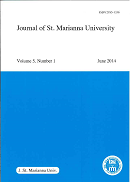Volume 10, Issue 2
Displaying 1-12 of 12 articles from this issue
- |<
- <
- 1
- >
- >|
original article
-
2019Volume 10Issue 2 Pages 19-26
Published: 2019
Released on J-STAGE: January 27, 2020
Download PDF (1096K) -
2019Volume 10Issue 2 Pages 27-37
Published: 2019
Released on J-STAGE: January 27, 2020
Download PDF (5665K) -
2019Volume 10Issue 2 Pages 39-49
Published: 2019
Released on J-STAGE: January 27, 2020
Download PDF (1735K) -
2019Volume 10Issue 2 Pages 51-61
Published: 2019
Released on J-STAGE: January 27, 2020
Download PDF (2613K) -
2019Volume 10Issue 2 Pages 63-70
Published: 2019
Released on J-STAGE: January 27, 2020
Download PDF (1257K) -
2019Volume 10Issue 2 Pages 71-79
Published: 2019
Released on J-STAGE: January 27, 2020
Download PDF (3745K) -
2019Volume 10Issue 2 Pages 81-87
Published: 2019
Released on J-STAGE: January 27, 2020
Download PDF (1517K) -
2019Volume 10Issue 2 Pages 89-94
Published: 2019
Released on J-STAGE: January 27, 2020
Download PDF (439K)
case report
-
2019Volume 10Issue 2 Pages 95-101
Published: 2019
Released on J-STAGE: January 27, 2020
Download PDF (7089K) -
2019Volume 10Issue 2 Pages 103-107
Published: 2019
Released on J-STAGE: January 27, 2020
Download PDF (487K) -
2019Volume 10Issue 2 Pages 109-114
Published: 2019
Released on J-STAGE: January 27, 2020
Download PDF (2785K) -
2019Volume 10Issue 2 Pages 115-121
Published: 2019
Released on J-STAGE: January 27, 2020
Download PDF (3515K)
- |<
- <
- 1
- >
- >|
